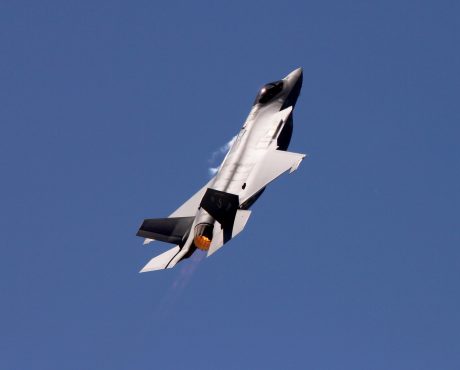Why Lockheed Martin Corporation Could Be Special
For the most part, defense contractors haven’t exactly been the go-to choice for income investors. But if you decide to ignore Lockheed Martin Corporation (NYSE:LMT), you could be missing out on a big opportunity.
You see, it’s earnings season. And because of the COVID-19 pandemic, things don’t look very rosy at most companies. S&P 500 companies that released their second-quarter results by July 17 reported a blended year-over-year earnings decline of 44% and a blended year-over-year revenue decline of 10.5%. (Source: “Earnings Insight,” FactSet Research Systems Inc., July 17, 2020.)
And that could be concerning for income investors. When profits drop by that much—even if it’s temporary—companies may rethink their dividend policy. It doesn’t help that the second wave of the coronavirus could be looming in the distance. In fact, we’ve already seen a bunch of dividend cuts across industries.
Wouldn’t it be nice to have a company that can grow both its sales and profits despite the challenging environment?
Well, Lockheed Martin fits that description perfectly.
Known for its “F-35” fighter jets, Lockheed Martin is one of the largest aerospace and defense companies in the world. It operates through four main segments: “Aeronautics,” “Missiles and Fire Control,” “Rotary and Mission Systems,” and “Space.”
In the second quarter of 2020, every one of those four segments delivered higher net sales year-over-year. Added up, Lockheed Martin generated $16.2 billion of revenue for the quarter, representing a 12.4% increase from a year ago. (Source: “Lockheed Martin Reports Second Quarter 2020 Results,” Lockheed Martin Corporation, July 21, 2020.)
The bottom line improved as well. The company’s net earnings came in at $1.6 billion, or $5.79 per share in the second quarter of 2020, up from the $1.4 billion, or $5.00 per share, earned in the year-ago period.
Note that the bottom-line number included an after-tax non-cash impairment charge of $96.0 million, or $0.34 per share, for an investment in a joint venture that Lockheed Martin Corporation has entered into an agreement to sell. Excluding that charge, LMT would have earned a profit of $6.13 per share.
Considering that the company declared and paid a cash dividend of $2.40 per share during the second quarter, its net earnings covered the payout with ease.
It’s a similar story if you use cash flow to evaluate the company’s dividend safety.
Lockheed Martin’s cash from operations grew from $1.7 billion in the second quarter of 2019 to $2.2 billion in the latest reporting quarter. After subtracting $343.0 million in capital expenditures, it had $1.8 billion of free cash flow. And since the company paid LMT stock investors $671.0 million in dividends for the quarter, its free cash flow easily covered the payout. (Source: “2nd Quarter 2020 Earnings Results Conference Call,” Lockheed Martin Corporation, July 21, 2020.)
In fact, the company did more than just pay dividends. During the quarter, Lockheed Martin also repurchased 700,000 shares for $259.0 million. This reduced the number of shares outstanding, allowing each remaining investor to own a slightly larger portion of the company.
In a quarter when many companies suspended their stock buyback programs, LMT’s share repurchases show that management is determined to return cash to investors.
It should also be noted that, even though defense contractors are not known for their dividends, Lockheed Martin stock actually has a solid track record when it comes to growing its payout. Over the past decade, the company’s quarterly dividend rate went from $0.63 per share to $2.40 per share, translating to a total increase of 281%. (Source: “Dividend History,” Lockheed Martin Corporation, last accessed July 24, 2020.)
Of course, the pandemic is yet to end, and almost every industry is facing uncertainties. However, there is something about Lockheed Martin’s business that could give income investors peace of mind: backlog.
You see, as of June 28, Lockheed Martin had $150.3 billion of backlog across its four operating segments, marking a new record. As a matter of fact, the defense contractor has reported record backlog for eight consecutive quarters. (Source: “Lockheed Martin Reports Second Quarter 2020 Results,” Lockheed Martin Corporation, July 21, 2020, op. cit.)
The best part is, Lockheed Martin is actually raising its guidance for full-year 2020.
In April, management was projecting $62.3 to $64.0 billion in net sales, $23.65 to $23.95 in diluted earnings per share, and at least $7.6 billion in cash from operations. Now they expect the company to generate $63.5 to $65.0 billion in net sales, $23.75 to $24.05 in diluted earnings per share, and at least $8.0 billion in cash from operations. (Source: “2nd Quarter 2020 Earnings Results Conference Call,” Lockheed Martin Corporation, July 21, 2020.)
Lockheed Martin Corporation (NYSE:LMT) Stock Chart
Chart courtesy of StockCharts.com
Bottom line on Lockheed Martin Corporation
With an annual dividend yield of 2.5% at the time of this writing, Lockheed Martin stock probably doesn’t look very attractive to yield hunters. However, the company is actually offering a higher yield now that it was at the beginning of this year, for the simple reason that the LMT stock price is lower (as the above chart shows).
That’s right: even though every one of Lockheed Martin Corporation’s operating segments is firing on all cylinders, and even though the company generates extremely impressive growth rates in revenue, profit, and cash flow, its shares are cheaper than before.
In today’s market, quality stocks seldom go on sale. As it stands, LMT could be an opportunity for income investors.
